Financial Management Report: Samsung Electronics Co Ltd
VerifiedAdded on 2019/12/03
|19
|4967
|2518
Report
AI Summary
This report provides a comprehensive analysis of financial resource management and decision-making, focusing on Samsung Electronics Co Ltd. It begins by evaluating various sources of finance, including issuing shares, bank borrowings, and retained earnings, along with their implications and associated costs. The report emphasizes the significance of financial planning, detailing the information required by different stakeholders such as management, creditors, government, and employees. It further examines the impact of finance on financial statements like the income statement, cash flow statement, and balance sheet. The report then delves into budgeting, including cash, sales, and production budgets, and assesses the viability of investment projects using techniques like Net Present Value (NPV), Payback Period, Average Rate of Return (ARR), and Internal Rate of Return (IRR). Finally, it concludes with a discussion on the purpose and formats of financial statements, along with a detailed ratio analysis of Samsung Electronics Co Ltd, offering insights into its financial position and performance.

MANAGING FINANCIAL RESOURCES
AND DECISIONS
1
AND DECISIONS
1
Paraphrase This Document
Need a fresh take? Get an instant paraphrase of this document with our AI Paraphraser
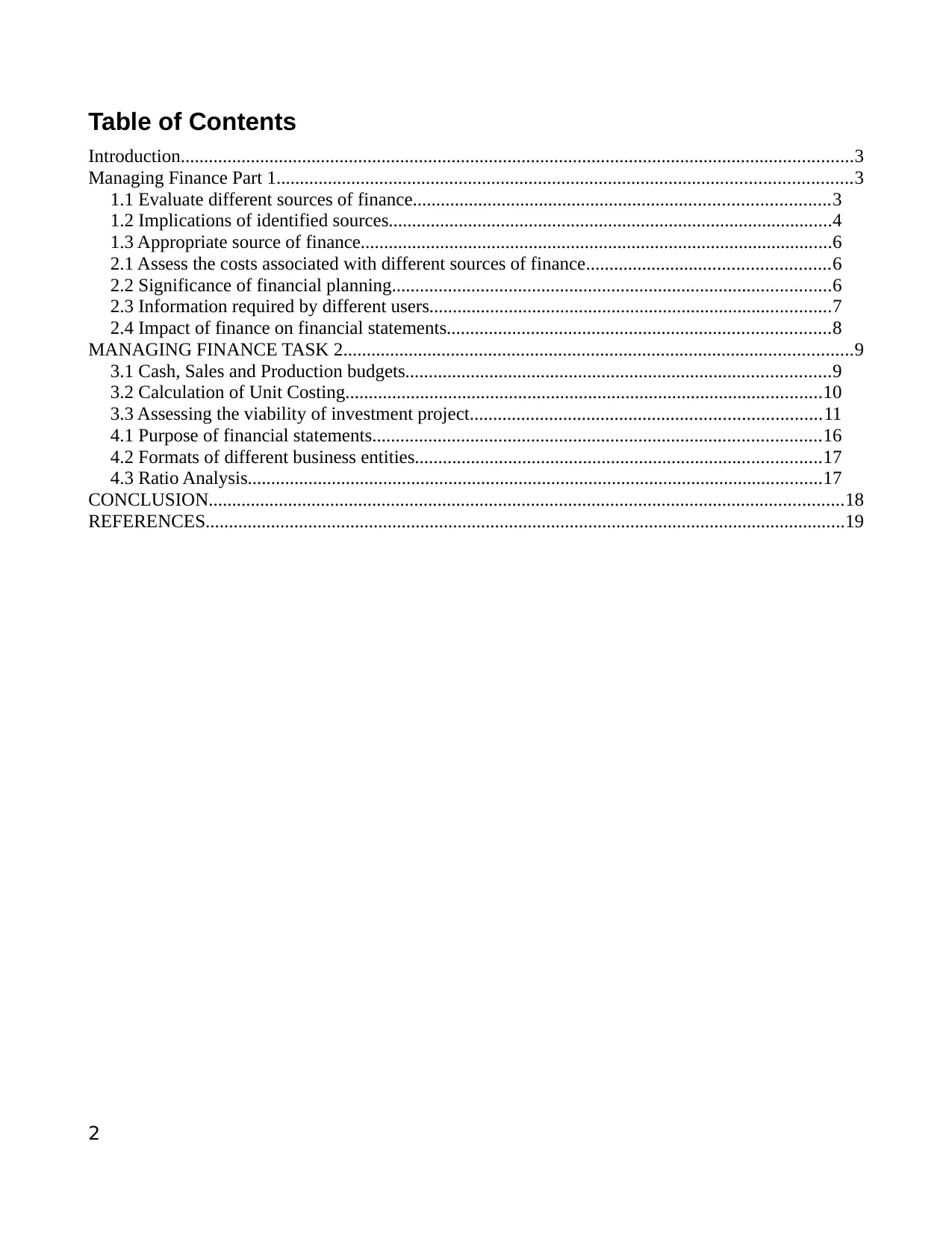
Table of Contents
Introduction................................................................................................................................................3
Managing Finance Part 1...........................................................................................................................3
1.1 Evaluate different sources of finance.........................................................................................3
1.2 Implications of identified sources...............................................................................................4
1.3 Appropriate source of finance.....................................................................................................6
2.1 Assess the costs associated with different sources of finance....................................................6
2.2 Significance of financial planning..............................................................................................6
2.3 Information required by different users......................................................................................7
2.4 Impact of finance on financial statements..................................................................................8
MANAGING FINANCE TASK 2.............................................................................................................9
3.1 Cash, Sales and Production budgets...........................................................................................9
3.2 Calculation of Unit Costing......................................................................................................10
3.3 Assessing the viability of investment project...........................................................................11
4.1 Purpose of financial statements................................................................................................16
4.2 Formats of different business entities.......................................................................................17
4.3 Ratio Analysis...........................................................................................................................17
CONCLUSION........................................................................................................................................18
REFERENCES.........................................................................................................................................19
2
Introduction................................................................................................................................................3
Managing Finance Part 1...........................................................................................................................3
1.1 Evaluate different sources of finance.........................................................................................3
1.2 Implications of identified sources...............................................................................................4
1.3 Appropriate source of finance.....................................................................................................6
2.1 Assess the costs associated with different sources of finance....................................................6
2.2 Significance of financial planning..............................................................................................6
2.3 Information required by different users......................................................................................7
2.4 Impact of finance on financial statements..................................................................................8
MANAGING FINANCE TASK 2.............................................................................................................9
3.1 Cash, Sales and Production budgets...........................................................................................9
3.2 Calculation of Unit Costing......................................................................................................10
3.3 Assessing the viability of investment project...........................................................................11
4.1 Purpose of financial statements................................................................................................16
4.2 Formats of different business entities.......................................................................................17
4.3 Ratio Analysis...........................................................................................................................17
CONCLUSION........................................................................................................................................18
REFERENCES.........................................................................................................................................19
2
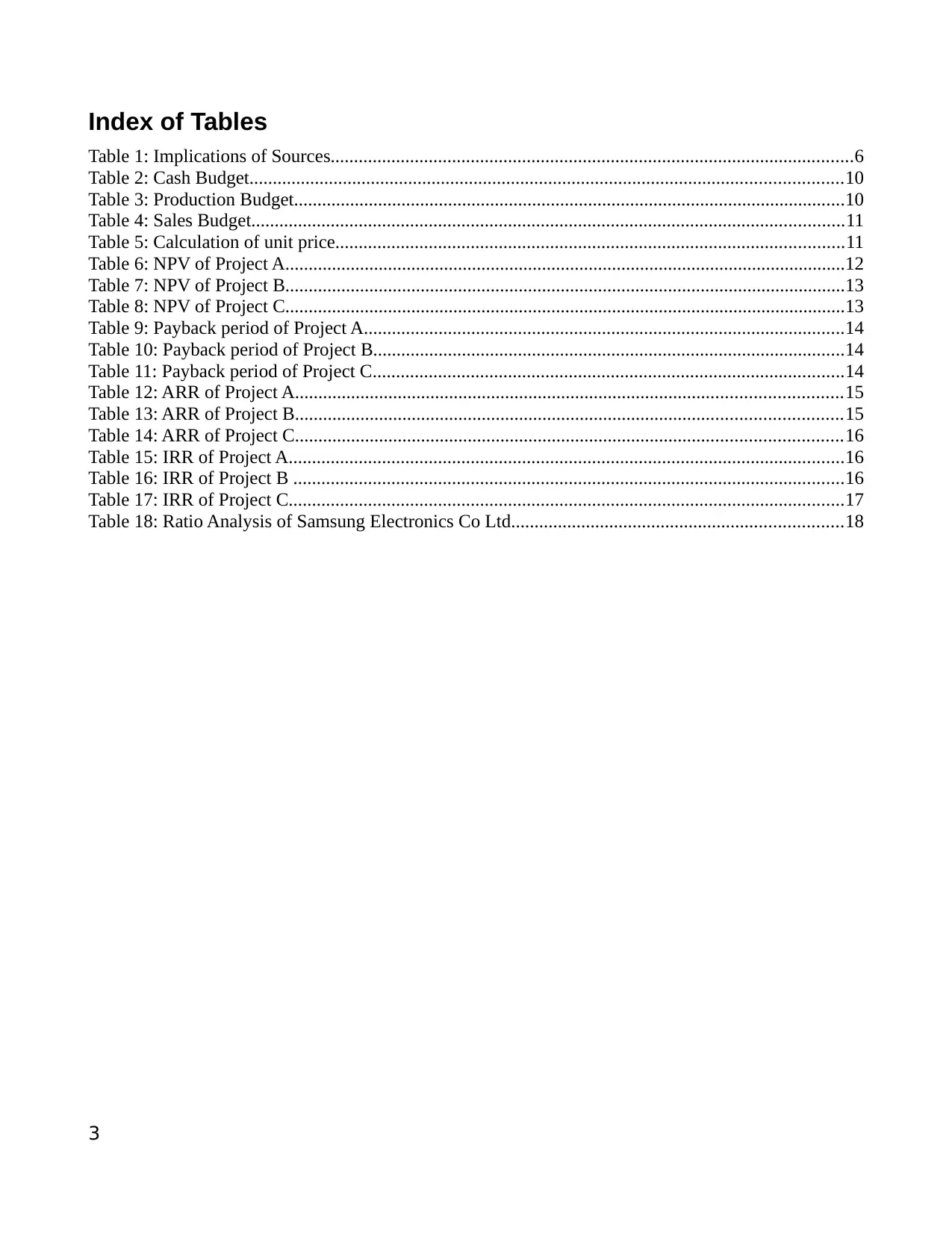
Index of Tables
Table 1: Implications of Sources................................................................................................................6
Table 2: Cash Budget...............................................................................................................................10
Table 3: Production Budget......................................................................................................................10
Table 4: Sales Budget...............................................................................................................................11
Table 5: Calculation of unit price.............................................................................................................11
Table 6: NPV of Project A........................................................................................................................12
Table 7: NPV of Project B........................................................................................................................13
Table 8: NPV of Project C........................................................................................................................13
Table 9: Payback period of Project A.......................................................................................................14
Table 10: Payback period of Project B.....................................................................................................14
Table 11: Payback period of Project C.....................................................................................................14
Table 12: ARR of Project A.....................................................................................................................15
Table 13: ARR of Project B.....................................................................................................................15
Table 14: ARR of Project C.....................................................................................................................16
Table 15: IRR of Project A.......................................................................................................................16
Table 16: IRR of Project B ......................................................................................................................16
Table 17: IRR of Project C.......................................................................................................................17
Table 18: Ratio Analysis of Samsung Electronics Co Ltd.......................................................................18
3
Table 1: Implications of Sources................................................................................................................6
Table 2: Cash Budget...............................................................................................................................10
Table 3: Production Budget......................................................................................................................10
Table 4: Sales Budget...............................................................................................................................11
Table 5: Calculation of unit price.............................................................................................................11
Table 6: NPV of Project A........................................................................................................................12
Table 7: NPV of Project B........................................................................................................................13
Table 8: NPV of Project C........................................................................................................................13
Table 9: Payback period of Project A.......................................................................................................14
Table 10: Payback period of Project B.....................................................................................................14
Table 11: Payback period of Project C.....................................................................................................14
Table 12: ARR of Project A.....................................................................................................................15
Table 13: ARR of Project B.....................................................................................................................15
Table 14: ARR of Project C.....................................................................................................................16
Table 15: IRR of Project A.......................................................................................................................16
Table 16: IRR of Project B ......................................................................................................................16
Table 17: IRR of Project C.......................................................................................................................17
Table 18: Ratio Analysis of Samsung Electronics Co Ltd.......................................................................18
3
⊘ This is a preview!⊘
Do you want full access?
Subscribe today to unlock all pages.

Trusted by 1+ million students worldwide
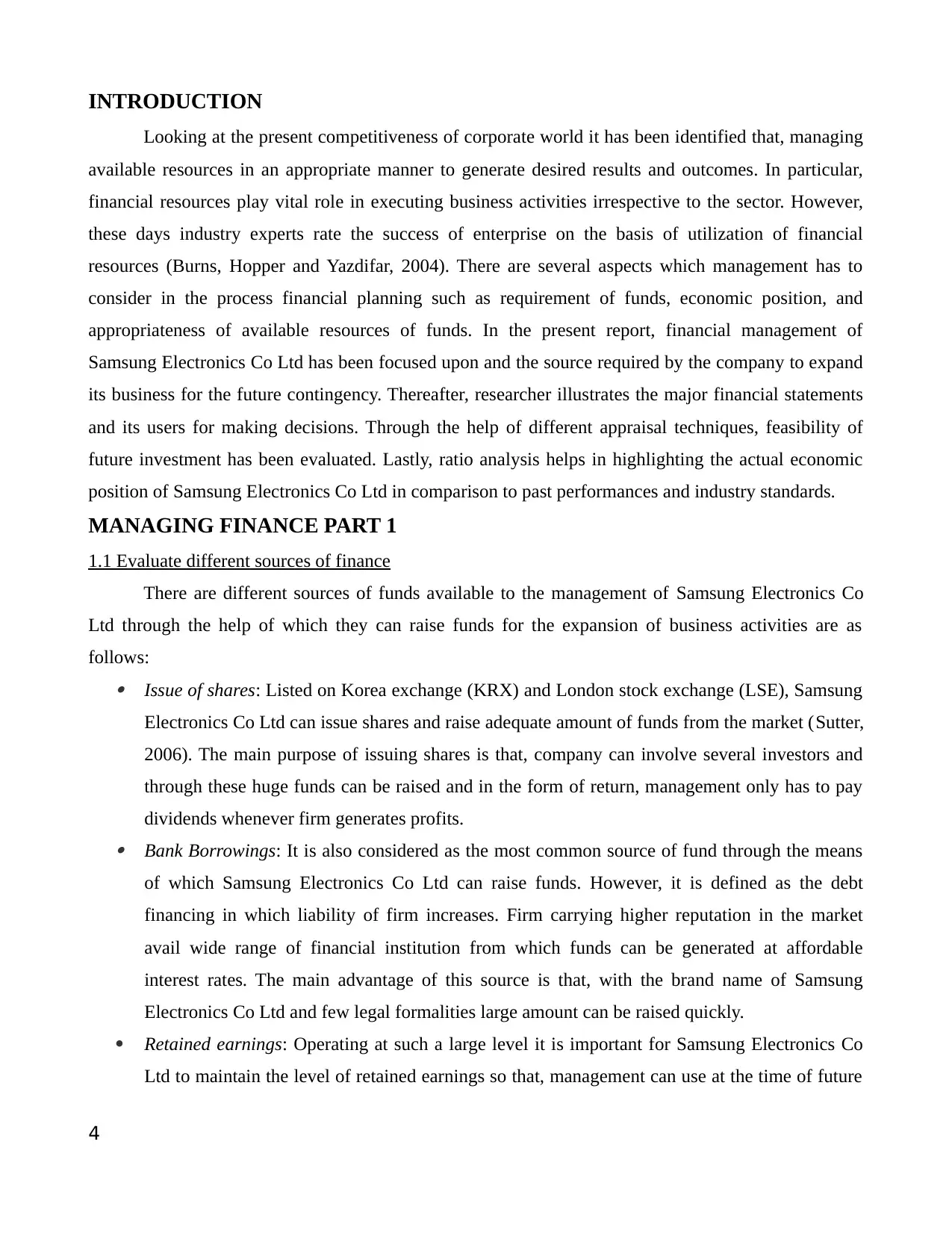
INTRODUCTION
Looking at the present competitiveness of corporate world it has been identified that, managing
available resources in an appropriate manner to generate desired results and outcomes. In particular,
financial resources play vital role in executing business activities irrespective to the sector. However,
these days industry experts rate the success of enterprise on the basis of utilization of financial
resources (Burns, Hopper and Yazdifar, 2004). There are several aspects which management has to
consider in the process financial planning such as requirement of funds, economic position, and
appropriateness of available resources of funds. In the present report, financial management of
Samsung Electronics Co Ltd has been focused upon and the source required by the company to expand
its business for the future contingency. Thereafter, researcher illustrates the major financial statements
and its users for making decisions. Through the help of different appraisal techniques, feasibility of
future investment has been evaluated. Lastly, ratio analysis helps in highlighting the actual economic
position of Samsung Electronics Co Ltd in comparison to past performances and industry standards.
MANAGING FINANCE PART 1
1.1 Evaluate different sources of finance
There are different sources of funds available to the management of Samsung Electronics Co
Ltd through the help of which they can raise funds for the expansion of business activities are as
follows: Issue of shares: Listed on Korea exchange (KRX) and London stock exchange (LSE), Samsung
Electronics Co Ltd can issue shares and raise adequate amount of funds from the market (Sutter,
2006). The main purpose of issuing shares is that, company can involve several investors and
through these huge funds can be raised and in the form of return, management only has to pay
dividends whenever firm generates profits. Bank Borrowings: It is also considered as the most common source of fund through the means
of which Samsung Electronics Co Ltd can raise funds. However, it is defined as the debt
financing in which liability of firm increases. Firm carrying higher reputation in the market
avail wide range of financial institution from which funds can be generated at affordable
interest rates. The main advantage of this source is that, with the brand name of Samsung
Electronics Co Ltd and few legal formalities large amount can be raised quickly.
Retained earnings: Operating at such a large level it is important for Samsung Electronics Co
Ltd to maintain the level of retained earnings so that, management can use at the time of future
4
Looking at the present competitiveness of corporate world it has been identified that, managing
available resources in an appropriate manner to generate desired results and outcomes. In particular,
financial resources play vital role in executing business activities irrespective to the sector. However,
these days industry experts rate the success of enterprise on the basis of utilization of financial
resources (Burns, Hopper and Yazdifar, 2004). There are several aspects which management has to
consider in the process financial planning such as requirement of funds, economic position, and
appropriateness of available resources of funds. In the present report, financial management of
Samsung Electronics Co Ltd has been focused upon and the source required by the company to expand
its business for the future contingency. Thereafter, researcher illustrates the major financial statements
and its users for making decisions. Through the help of different appraisal techniques, feasibility of
future investment has been evaluated. Lastly, ratio analysis helps in highlighting the actual economic
position of Samsung Electronics Co Ltd in comparison to past performances and industry standards.
MANAGING FINANCE PART 1
1.1 Evaluate different sources of finance
There are different sources of funds available to the management of Samsung Electronics Co
Ltd through the help of which they can raise funds for the expansion of business activities are as
follows: Issue of shares: Listed on Korea exchange (KRX) and London stock exchange (LSE), Samsung
Electronics Co Ltd can issue shares and raise adequate amount of funds from the market (Sutter,
2006). The main purpose of issuing shares is that, company can involve several investors and
through these huge funds can be raised and in the form of return, management only has to pay
dividends whenever firm generates profits. Bank Borrowings: It is also considered as the most common source of fund through the means
of which Samsung Electronics Co Ltd can raise funds. However, it is defined as the debt
financing in which liability of firm increases. Firm carrying higher reputation in the market
avail wide range of financial institution from which funds can be generated at affordable
interest rates. The main advantage of this source is that, with the brand name of Samsung
Electronics Co Ltd and few legal formalities large amount can be raised quickly.
Retained earnings: Operating at such a large level it is important for Samsung Electronics Co
Ltd to maintain the level of retained earnings so that, management can use at the time of future
4
Paraphrase This Document
Need a fresh take? Get an instant paraphrase of this document with our AI Paraphraser
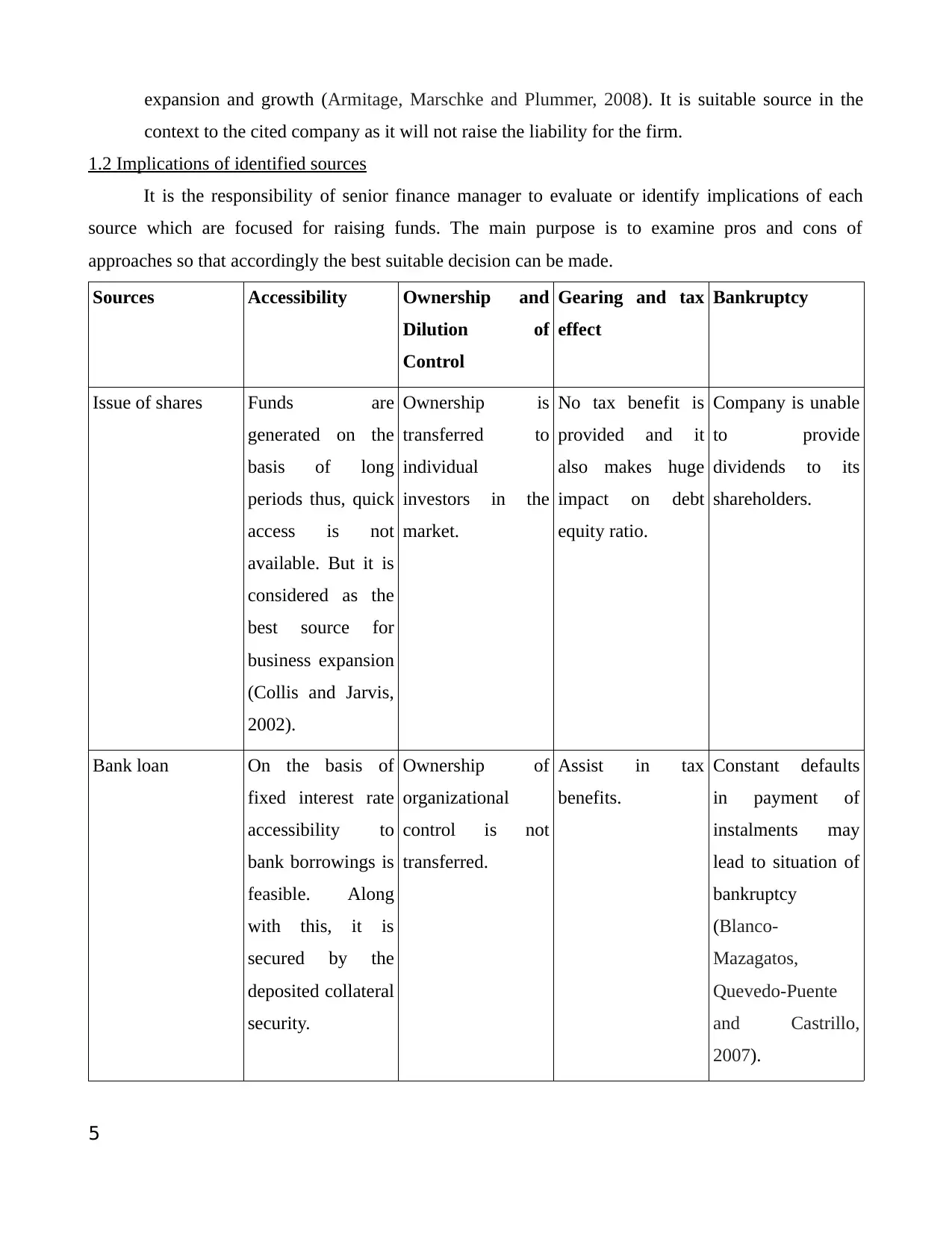
expansion and growth (Armitage, Marschke and Plummer, 2008). It is suitable source in the
context to the cited company as it will not raise the liability for the firm.
1.2 Implications of identified sources
It is the responsibility of senior finance manager to evaluate or identify implications of each
source which are focused for raising funds. The main purpose is to examine pros and cons of
approaches so that accordingly the best suitable decision can be made.
Sources Accessibility Ownership and
Dilution of
Control
Gearing and tax
effect
Bankruptcy
Issue of shares Funds are
generated on the
basis of long
periods thus, quick
access is not
available. But it is
considered as the
best source for
business expansion
(Collis and Jarvis,
2002).
Ownership is
transferred to
individual
investors in the
market.
No tax benefit is
provided and it
also makes huge
impact on debt
equity ratio.
Company is unable
to provide
dividends to its
shareholders.
Bank loan On the basis of
fixed interest rate
accessibility to
bank borrowings is
feasible. Along
with this, it is
secured by the
deposited collateral
security.
Ownership of
organizational
control is not
transferred.
Assist in tax
benefits.
Constant defaults
in payment of
instalments may
lead to situation of
bankruptcy
(Blanco‐
Mazagatos,
Quevedo‐Puente
and Castrillo,
2007).
5
context to the cited company as it will not raise the liability for the firm.
1.2 Implications of identified sources
It is the responsibility of senior finance manager to evaluate or identify implications of each
source which are focused for raising funds. The main purpose is to examine pros and cons of
approaches so that accordingly the best suitable decision can be made.
Sources Accessibility Ownership and
Dilution of
Control
Gearing and tax
effect
Bankruptcy
Issue of shares Funds are
generated on the
basis of long
periods thus, quick
access is not
available. But it is
considered as the
best source for
business expansion
(Collis and Jarvis,
2002).
Ownership is
transferred to
individual
investors in the
market.
No tax benefit is
provided and it
also makes huge
impact on debt
equity ratio.
Company is unable
to provide
dividends to its
shareholders.
Bank loan On the basis of
fixed interest rate
accessibility to
bank borrowings is
feasible. Along
with this, it is
secured by the
deposited collateral
security.
Ownership of
organizational
control is not
transferred.
Assist in tax
benefits.
Constant defaults
in payment of
instalments may
lead to situation of
bankruptcy
(Blanco‐
Mazagatos,
Quevedo‐Puente
and Castrillo,
2007).
5
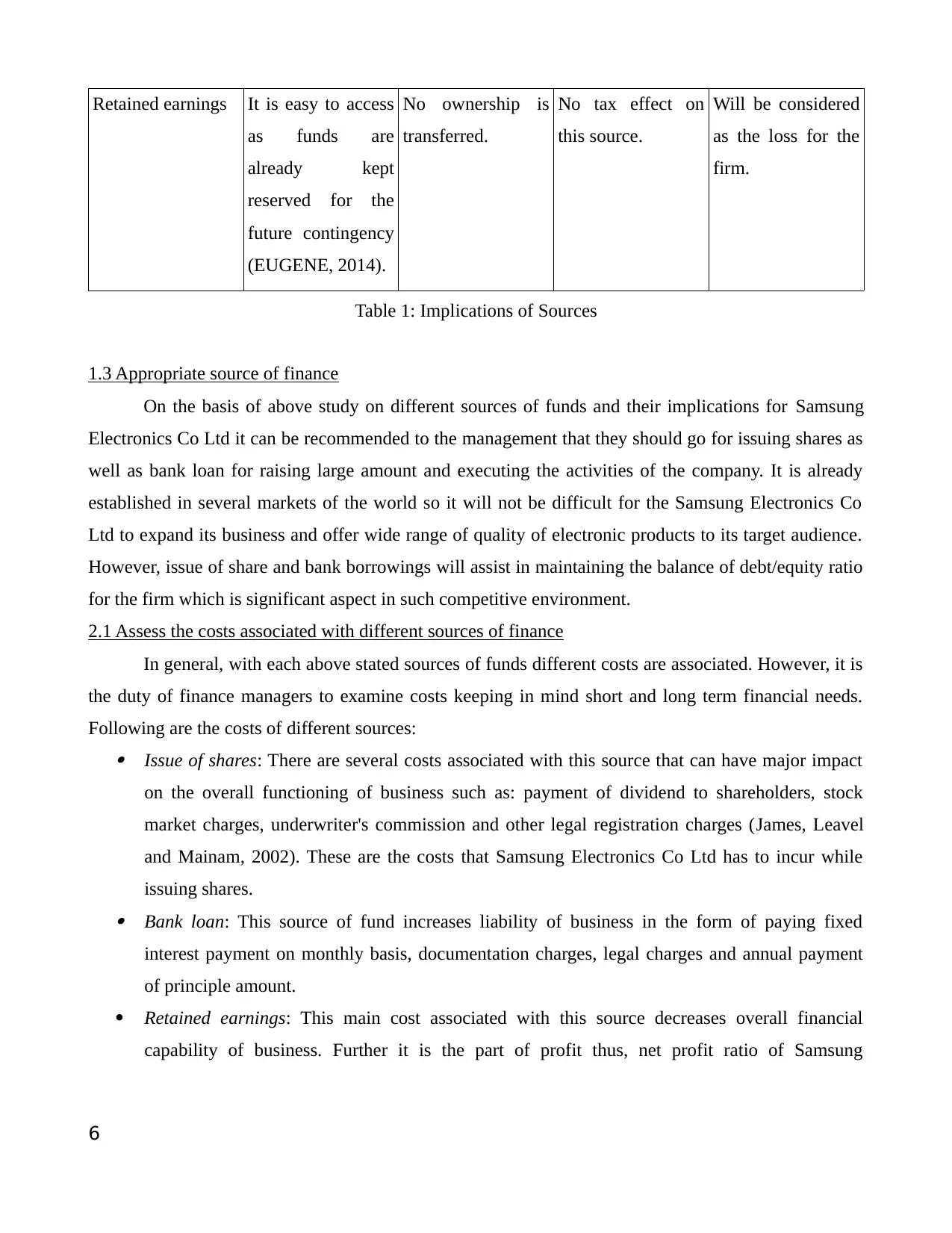
Retained earnings It is easy to access
as funds are
already kept
reserved for the
future contingency
(EUGENE, 2014).
No ownership is
transferred.
No tax effect on
this source.
Will be considered
as the loss for the
firm.
Table 1: Implications of Sources
1.3 Appropriate source of finance
On the basis of above study on different sources of funds and their implications for Samsung
Electronics Co Ltd it can be recommended to the management that they should go for issuing shares as
well as bank loan for raising large amount and executing the activities of the company. It is already
established in several markets of the world so it will not be difficult for the Samsung Electronics Co
Ltd to expand its business and offer wide range of quality of electronic products to its target audience.
However, issue of share and bank borrowings will assist in maintaining the balance of debt/equity ratio
for the firm which is significant aspect in such competitive environment.
2.1 Assess the costs associated with different sources of finance
In general, with each above stated sources of funds different costs are associated. However, it is
the duty of finance managers to examine costs keeping in mind short and long term financial needs.
Following are the costs of different sources: Issue of shares: There are several costs associated with this source that can have major impact
on the overall functioning of business such as: payment of dividend to shareholders, stock
market charges, underwriter's commission and other legal registration charges (James, Leavel
and Mainam, 2002). These are the costs that Samsung Electronics Co Ltd has to incur while
issuing shares. Bank loan: This source of fund increases liability of business in the form of paying fixed
interest payment on monthly basis, documentation charges, legal charges and annual payment
of principle amount.
Retained earnings: This main cost associated with this source decreases overall financial
capability of business. Further it is the part of profit thus, net profit ratio of Samsung
6
as funds are
already kept
reserved for the
future contingency
(EUGENE, 2014).
No ownership is
transferred.
No tax effect on
this source.
Will be considered
as the loss for the
firm.
Table 1: Implications of Sources
1.3 Appropriate source of finance
On the basis of above study on different sources of funds and their implications for Samsung
Electronics Co Ltd it can be recommended to the management that they should go for issuing shares as
well as bank loan for raising large amount and executing the activities of the company. It is already
established in several markets of the world so it will not be difficult for the Samsung Electronics Co
Ltd to expand its business and offer wide range of quality of electronic products to its target audience.
However, issue of share and bank borrowings will assist in maintaining the balance of debt/equity ratio
for the firm which is significant aspect in such competitive environment.
2.1 Assess the costs associated with different sources of finance
In general, with each above stated sources of funds different costs are associated. However, it is
the duty of finance managers to examine costs keeping in mind short and long term financial needs.
Following are the costs of different sources: Issue of shares: There are several costs associated with this source that can have major impact
on the overall functioning of business such as: payment of dividend to shareholders, stock
market charges, underwriter's commission and other legal registration charges (James, Leavel
and Mainam, 2002). These are the costs that Samsung Electronics Co Ltd has to incur while
issuing shares. Bank loan: This source of fund increases liability of business in the form of paying fixed
interest payment on monthly basis, documentation charges, legal charges and annual payment
of principle amount.
Retained earnings: This main cost associated with this source decreases overall financial
capability of business. Further it is the part of profit thus, net profit ratio of Samsung
6
⊘ This is a preview!⊘
Do you want full access?
Subscribe today to unlock all pages.

Trusted by 1+ million students worldwide
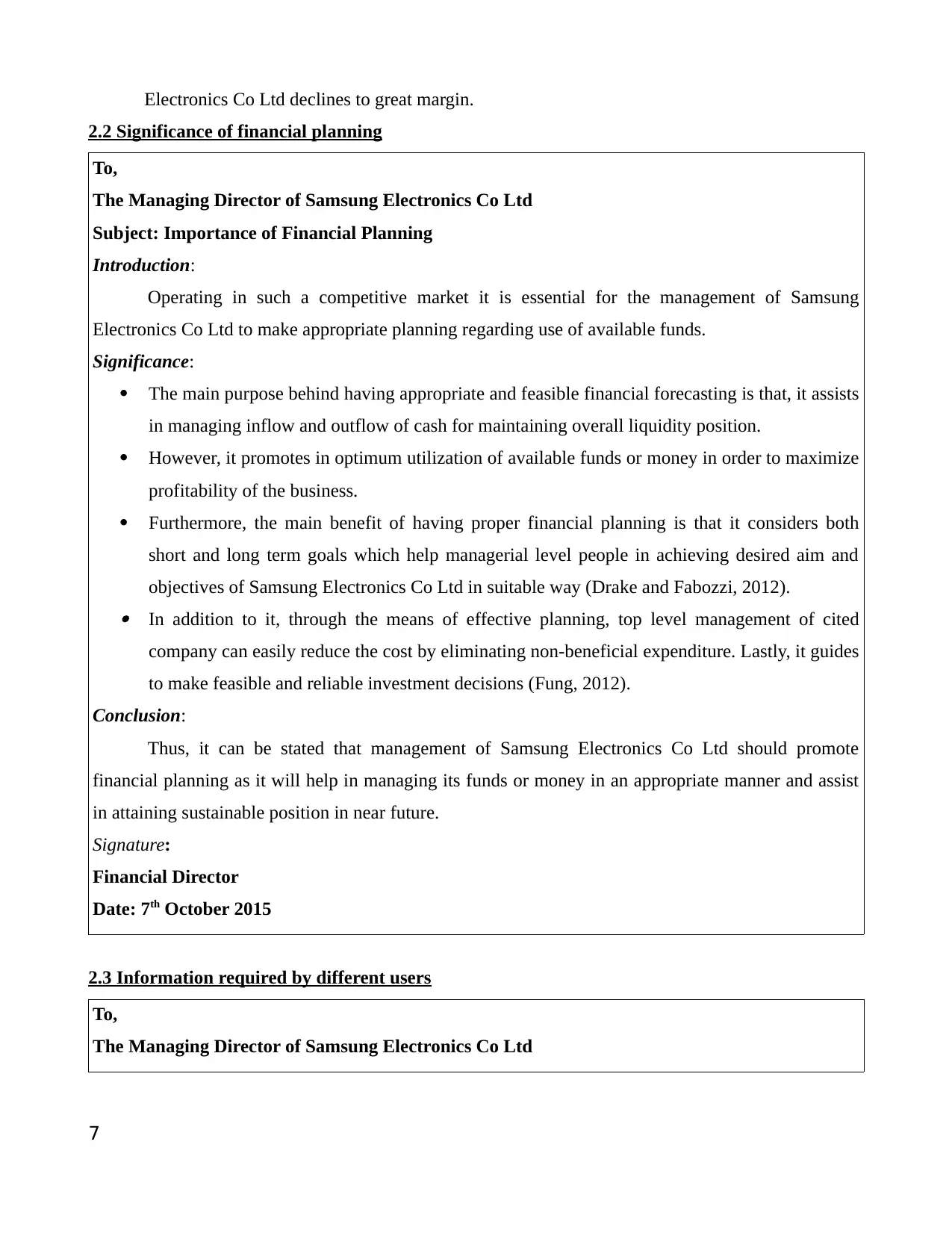
Electronics Co Ltd declines to great margin.
2.2 Significance of financial planning
To,
The Managing Director of Samsung Electronics Co Ltd
Subject: Importance of Financial Planning
Introduction:
Operating in such a competitive market it is essential for the management of Samsung
Electronics Co Ltd to make appropriate planning regarding use of available funds.
Significance:
The main purpose behind having appropriate and feasible financial forecasting is that, it assists
in managing inflow and outflow of cash for maintaining overall liquidity position.
However, it promotes in optimum utilization of available funds or money in order to maximize
profitability of the business.
Furthermore, the main benefit of having proper financial planning is that it considers both
short and long term goals which help managerial level people in achieving desired aim and
objectives of Samsung Electronics Co Ltd in suitable way (Drake and Fabozzi, 2012). In addition to it, through the means of effective planning, top level management of cited
company can easily reduce the cost by eliminating non-beneficial expenditure. Lastly, it guides
to make feasible and reliable investment decisions (Fung, 2012).
Conclusion:
Thus, it can be stated that management of Samsung Electronics Co Ltd should promote
financial planning as it will help in managing its funds or money in an appropriate manner and assist
in attaining sustainable position in near future.
Signature:
Financial Director
Date: 7th October 2015
2.3 Information required by different users
To,
The Managing Director of Samsung Electronics Co Ltd
7
2.2 Significance of financial planning
To,
The Managing Director of Samsung Electronics Co Ltd
Subject: Importance of Financial Planning
Introduction:
Operating in such a competitive market it is essential for the management of Samsung
Electronics Co Ltd to make appropriate planning regarding use of available funds.
Significance:
The main purpose behind having appropriate and feasible financial forecasting is that, it assists
in managing inflow and outflow of cash for maintaining overall liquidity position.
However, it promotes in optimum utilization of available funds or money in order to maximize
profitability of the business.
Furthermore, the main benefit of having proper financial planning is that it considers both
short and long term goals which help managerial level people in achieving desired aim and
objectives of Samsung Electronics Co Ltd in suitable way (Drake and Fabozzi, 2012). In addition to it, through the means of effective planning, top level management of cited
company can easily reduce the cost by eliminating non-beneficial expenditure. Lastly, it guides
to make feasible and reliable investment decisions (Fung, 2012).
Conclusion:
Thus, it can be stated that management of Samsung Electronics Co Ltd should promote
financial planning as it will help in managing its funds or money in an appropriate manner and assist
in attaining sustainable position in near future.
Signature:
Financial Director
Date: 7th October 2015
2.3 Information required by different users
To,
The Managing Director of Samsung Electronics Co Ltd
7
Paraphrase This Document
Need a fresh take? Get an instant paraphrase of this document with our AI Paraphraser
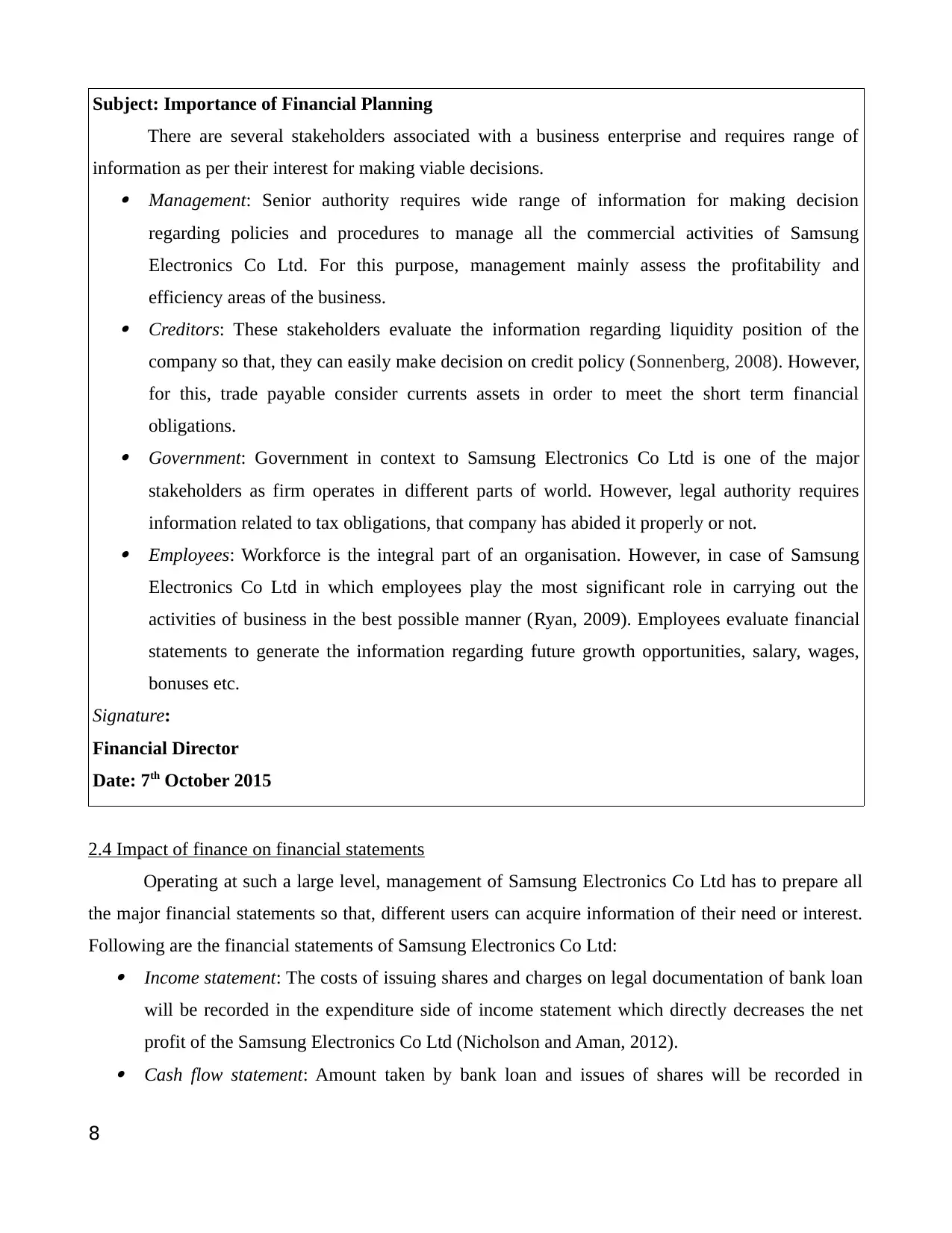
Subject: Importance of Financial Planning
There are several stakeholders associated with a business enterprise and requires range of
information as per their interest for making viable decisions. Management: Senior authority requires wide range of information for making decision
regarding policies and procedures to manage all the commercial activities of Samsung
Electronics Co Ltd. For this purpose, management mainly assess the profitability and
efficiency areas of the business. Creditors: These stakeholders evaluate the information regarding liquidity position of the
company so that, they can easily make decision on credit policy (Sonnenberg, 2008). However,
for this, trade payable consider currents assets in order to meet the short term financial
obligations. Government: Government in context to Samsung Electronics Co Ltd is one of the major
stakeholders as firm operates in different parts of world. However, legal authority requires
information related to tax obligations, that company has abided it properly or not. Employees: Workforce is the integral part of an organisation. However, in case of Samsung
Electronics Co Ltd in which employees play the most significant role in carrying out the
activities of business in the best possible manner (Ryan, 2009). Employees evaluate financial
statements to generate the information regarding future growth opportunities, salary, wages,
bonuses etc.
Signature:
Financial Director
Date: 7th October 2015
2.4 Impact of finance on financial statements
Operating at such a large level, management of Samsung Electronics Co Ltd has to prepare all
the major financial statements so that, different users can acquire information of their need or interest.
Following are the financial statements of Samsung Electronics Co Ltd: Income statement: The costs of issuing shares and charges on legal documentation of bank loan
will be recorded in the expenditure side of income statement which directly decreases the net
profit of the Samsung Electronics Co Ltd (Nicholson and Aman, 2012). Cash flow statement: Amount taken by bank loan and issues of shares will be recorded in
8
There are several stakeholders associated with a business enterprise and requires range of
information as per their interest for making viable decisions. Management: Senior authority requires wide range of information for making decision
regarding policies and procedures to manage all the commercial activities of Samsung
Electronics Co Ltd. For this purpose, management mainly assess the profitability and
efficiency areas of the business. Creditors: These stakeholders evaluate the information regarding liquidity position of the
company so that, they can easily make decision on credit policy (Sonnenberg, 2008). However,
for this, trade payable consider currents assets in order to meet the short term financial
obligations. Government: Government in context to Samsung Electronics Co Ltd is one of the major
stakeholders as firm operates in different parts of world. However, legal authority requires
information related to tax obligations, that company has abided it properly or not. Employees: Workforce is the integral part of an organisation. However, in case of Samsung
Electronics Co Ltd in which employees play the most significant role in carrying out the
activities of business in the best possible manner (Ryan, 2009). Employees evaluate financial
statements to generate the information regarding future growth opportunities, salary, wages,
bonuses etc.
Signature:
Financial Director
Date: 7th October 2015
2.4 Impact of finance on financial statements
Operating at such a large level, management of Samsung Electronics Co Ltd has to prepare all
the major financial statements so that, different users can acquire information of their need or interest.
Following are the financial statements of Samsung Electronics Co Ltd: Income statement: The costs of issuing shares and charges on legal documentation of bank loan
will be recorded in the expenditure side of income statement which directly decreases the net
profit of the Samsung Electronics Co Ltd (Nicholson and Aman, 2012). Cash flow statement: Amount taken by bank loan and issues of shares will be recorded in
8
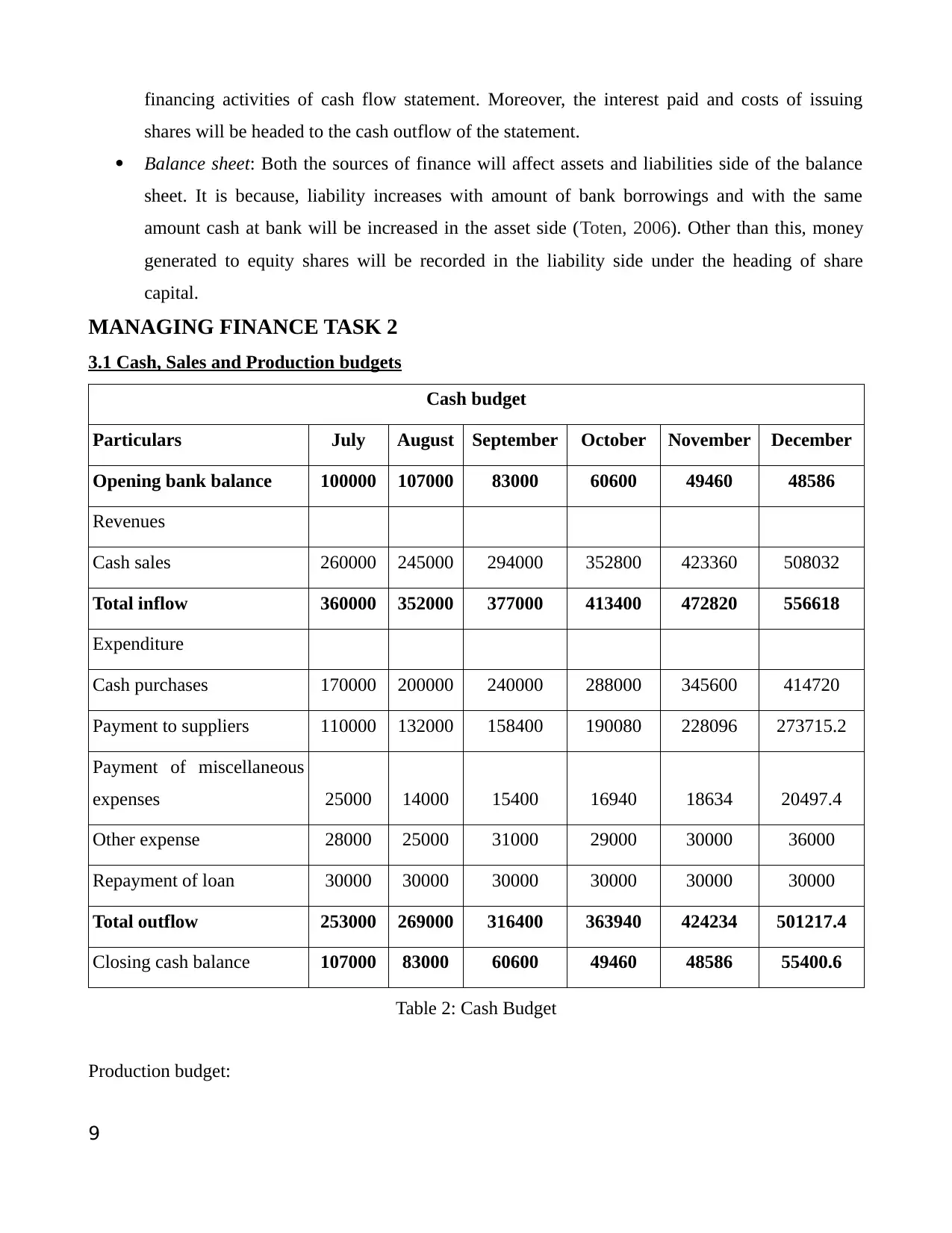
financing activities of cash flow statement. Moreover, the interest paid and costs of issuing
shares will be headed to the cash outflow of the statement.
Balance sheet: Both the sources of finance will affect assets and liabilities side of the balance
sheet. It is because, liability increases with amount of bank borrowings and with the same
amount cash at bank will be increased in the asset side (Toten, 2006). Other than this, money
generated to equity shares will be recorded in the liability side under the heading of share
capital.
MANAGING FINANCE TASK 2
3.1 Cash, Sales and Production budgets
Cash budget
Particulars July August September October November December
Opening bank balance 100000 107000 83000 60600 49460 48586
Revenues
Cash sales 260000 245000 294000 352800 423360 508032
Total inflow 360000 352000 377000 413400 472820 556618
Expenditure
Cash purchases 170000 200000 240000 288000 345600 414720
Payment to suppliers 110000 132000 158400 190080 228096 273715.2
Payment of miscellaneous
expenses 25000 14000 15400 16940 18634 20497.4
Other expense 28000 25000 31000 29000 30000 36000
Repayment of loan 30000 30000 30000 30000 30000 30000
Total outflow 253000 269000 316400 363940 424234 501217.4
Closing cash balance 107000 83000 60600 49460 48586 55400.6
Table 2: Cash Budget
Production budget:
9
shares will be headed to the cash outflow of the statement.
Balance sheet: Both the sources of finance will affect assets and liabilities side of the balance
sheet. It is because, liability increases with amount of bank borrowings and with the same
amount cash at bank will be increased in the asset side (Toten, 2006). Other than this, money
generated to equity shares will be recorded in the liability side under the heading of share
capital.
MANAGING FINANCE TASK 2
3.1 Cash, Sales and Production budgets
Cash budget
Particulars July August September October November December
Opening bank balance 100000 107000 83000 60600 49460 48586
Revenues
Cash sales 260000 245000 294000 352800 423360 508032
Total inflow 360000 352000 377000 413400 472820 556618
Expenditure
Cash purchases 170000 200000 240000 288000 345600 414720
Payment to suppliers 110000 132000 158400 190080 228096 273715.2
Payment of miscellaneous
expenses 25000 14000 15400 16940 18634 20497.4
Other expense 28000 25000 31000 29000 30000 36000
Repayment of loan 30000 30000 30000 30000 30000 30000
Total outflow 253000 269000 316400 363940 424234 501217.4
Closing cash balance 107000 83000 60600 49460 48586 55400.6
Table 2: Cash Budget
Production budget:
9
⊘ This is a preview!⊘
Do you want full access?
Subscribe today to unlock all pages.

Trusted by 1+ million students worldwide
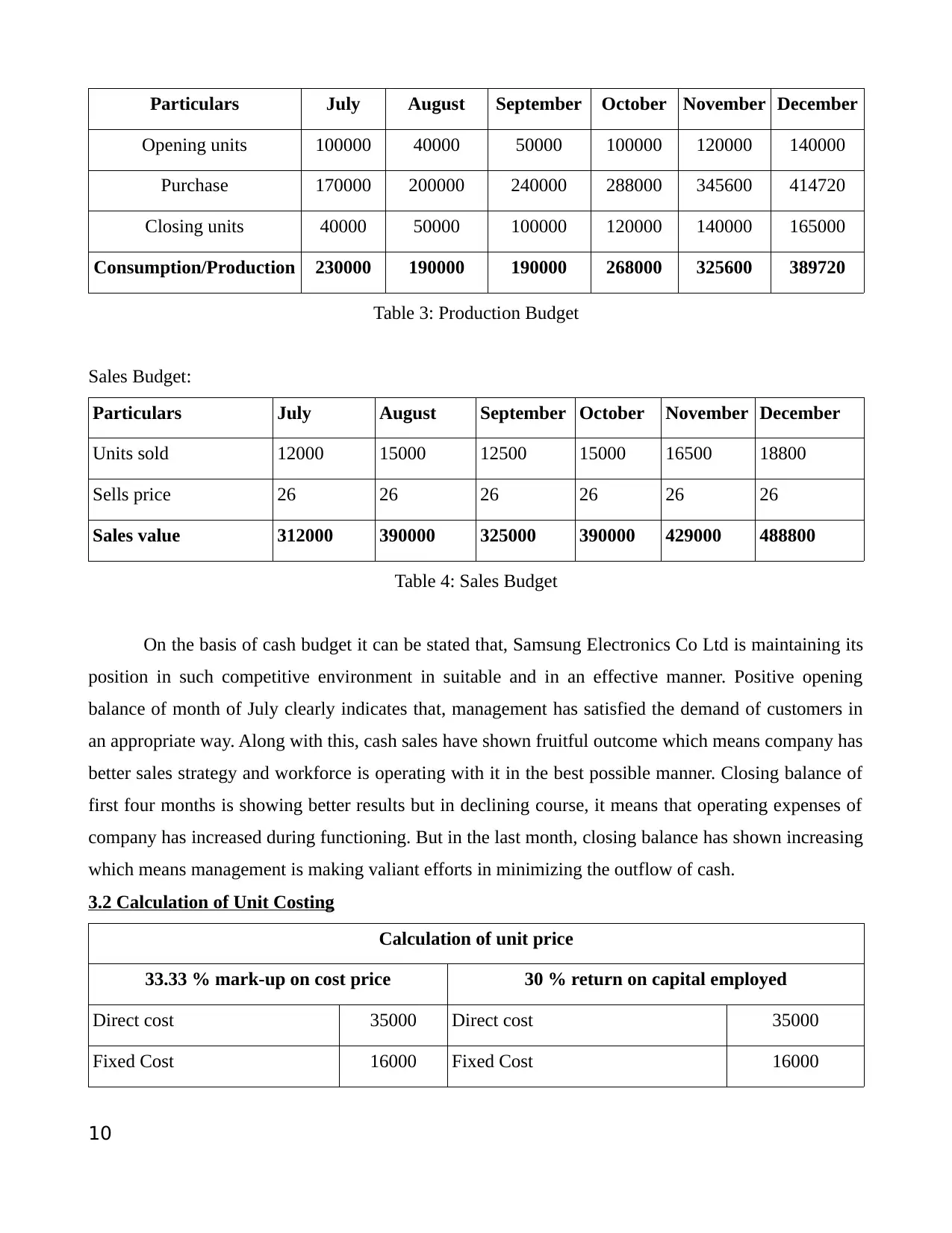
Particulars July August September October November December
Opening units 100000 40000 50000 100000 120000 140000
Purchase 170000 200000 240000 288000 345600 414720
Closing units 40000 50000 100000 120000 140000 165000
Consumption/Production 230000 190000 190000 268000 325600 389720
Table 3: Production Budget
Sales Budget:
Particulars July August September October November December
Units sold 12000 15000 12500 15000 16500 18800
Sells price 26 26 26 26 26 26
Sales value 312000 390000 325000 390000 429000 488800
Table 4: Sales Budget
On the basis of cash budget it can be stated that, Samsung Electronics Co Ltd is maintaining its
position in such competitive environment in suitable and in an effective manner. Positive opening
balance of month of July clearly indicates that, management has satisfied the demand of customers in
an appropriate way. Along with this, cash sales have shown fruitful outcome which means company has
better sales strategy and workforce is operating with it in the best possible manner. Closing balance of
first four months is showing better results but in declining course, it means that operating expenses of
company has increased during functioning. But in the last month, closing balance has shown increasing
which means management is making valiant efforts in minimizing the outflow of cash.
3.2 Calculation of Unit Costing
Calculation of unit price
33.33 % mark-up on cost price 30 % return on capital employed
Direct cost 35000 Direct cost 35000
Fixed Cost 16000 Fixed Cost 16000
10
Opening units 100000 40000 50000 100000 120000 140000
Purchase 170000 200000 240000 288000 345600 414720
Closing units 40000 50000 100000 120000 140000 165000
Consumption/Production 230000 190000 190000 268000 325600 389720
Table 3: Production Budget
Sales Budget:
Particulars July August September October November December
Units sold 12000 15000 12500 15000 16500 18800
Sells price 26 26 26 26 26 26
Sales value 312000 390000 325000 390000 429000 488800
Table 4: Sales Budget
On the basis of cash budget it can be stated that, Samsung Electronics Co Ltd is maintaining its
position in such competitive environment in suitable and in an effective manner. Positive opening
balance of month of July clearly indicates that, management has satisfied the demand of customers in
an appropriate way. Along with this, cash sales have shown fruitful outcome which means company has
better sales strategy and workforce is operating with it in the best possible manner. Closing balance of
first four months is showing better results but in declining course, it means that operating expenses of
company has increased during functioning. But in the last month, closing balance has shown increasing
which means management is making valiant efforts in minimizing the outflow of cash.
3.2 Calculation of Unit Costing
Calculation of unit price
33.33 % mark-up on cost price 30 % return on capital employed
Direct cost 35000 Direct cost 35000
Fixed Cost 16000 Fixed Cost 16000
10
Paraphrase This Document
Need a fresh take? Get an instant paraphrase of this document with our AI Paraphraser
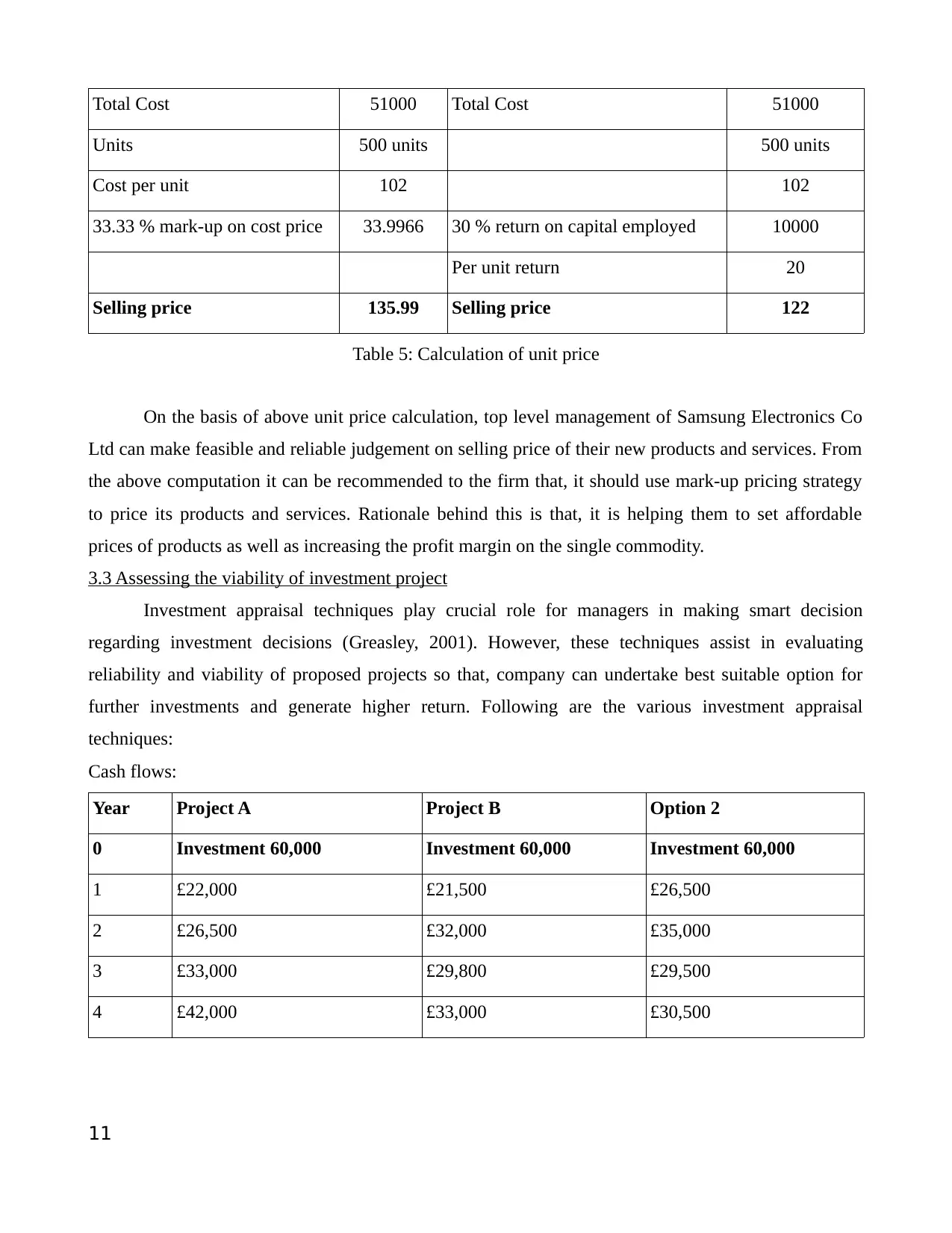
Total Cost 51000 Total Cost 51000
Units 500 units 500 units
Cost per unit 102 102
33.33 % mark-up on cost price 33.9966 30 % return on capital employed 10000
Per unit return 20
Selling price 135.99 Selling price 122
Table 5: Calculation of unit price
On the basis of above unit price calculation, top level management of Samsung Electronics Co
Ltd can make feasible and reliable judgement on selling price of their new products and services. From
the above computation it can be recommended to the firm that, it should use mark-up pricing strategy
to price its products and services. Rationale behind this is that, it is helping them to set affordable
prices of products as well as increasing the profit margin on the single commodity.
3.3 Assessing the viability of investment project
Investment appraisal techniques play crucial role for managers in making smart decision
regarding investment decisions (Greasley, 2001). However, these techniques assist in evaluating
reliability and viability of proposed projects so that, company can undertake best suitable option for
further investments and generate higher return. Following are the various investment appraisal
techniques:
Cash flows:
Year Project A Project B Option 2
0 Investment 60,000 Investment 60,000 Investment 60,000
1 £22,000 £21,500 £26,500
2 £26,500 £32,000 £35,000
3 £33,000 £29,800 £29,500
4 £42,000 £33,000 £30,500
11
Units 500 units 500 units
Cost per unit 102 102
33.33 % mark-up on cost price 33.9966 30 % return on capital employed 10000
Per unit return 20
Selling price 135.99 Selling price 122
Table 5: Calculation of unit price
On the basis of above unit price calculation, top level management of Samsung Electronics Co
Ltd can make feasible and reliable judgement on selling price of their new products and services. From
the above computation it can be recommended to the firm that, it should use mark-up pricing strategy
to price its products and services. Rationale behind this is that, it is helping them to set affordable
prices of products as well as increasing the profit margin on the single commodity.
3.3 Assessing the viability of investment project
Investment appraisal techniques play crucial role for managers in making smart decision
regarding investment decisions (Greasley, 2001). However, these techniques assist in evaluating
reliability and viability of proposed projects so that, company can undertake best suitable option for
further investments and generate higher return. Following are the various investment appraisal
techniques:
Cash flows:
Year Project A Project B Option 2
0 Investment 60,000 Investment 60,000 Investment 60,000
1 £22,000 £21,500 £26,500
2 £26,500 £32,000 £35,000
3 £33,000 £29,800 £29,500
4 £42,000 £33,000 £30,500
11
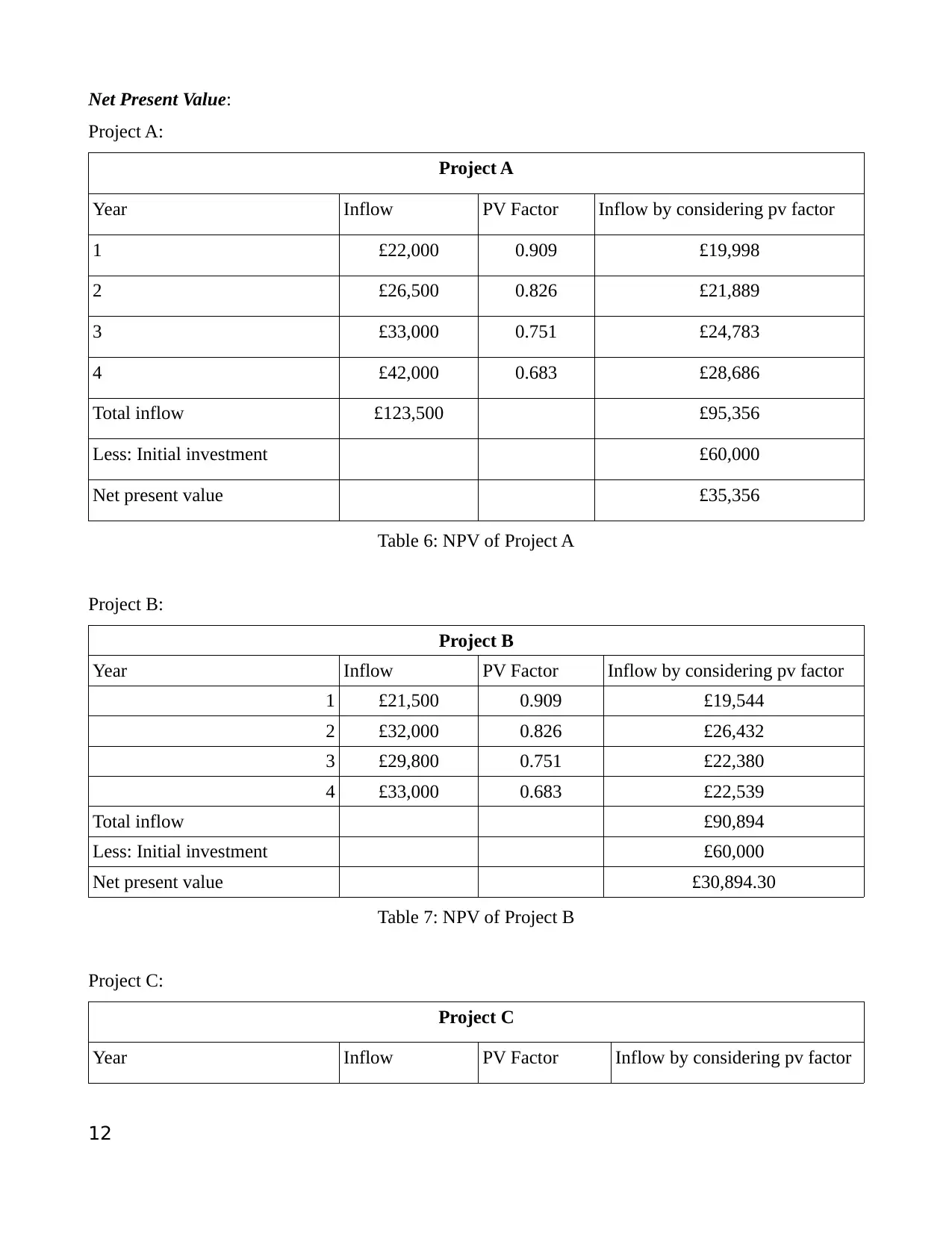
Net Present Value:
Project A:
Project A
Year Inflow PV Factor Inflow by considering pv factor
1 £22,000 0.909 £19,998
2 £26,500 0.826 £21,889
3 £33,000 0.751 £24,783
4 £42,000 0.683 £28,686
Total inflow £123,500 £95,356
Less: Initial investment £60,000
Net present value £35,356
Table 6: NPV of Project A
Project B:
Project B
Year Inflow PV Factor Inflow by considering pv factor
1 £21,500 0.909 £19,544
2 £32,000 0.826 £26,432
3 £29,800 0.751 £22,380
4 £33,000 0.683 £22,539
Total inflow £90,894
Less: Initial investment £60,000
Net present value £30,894.30
Table 7: NPV of Project B
Project C:
Project C
Year Inflow PV Factor Inflow by considering pv factor
12
Project A:
Project A
Year Inflow PV Factor Inflow by considering pv factor
1 £22,000 0.909 £19,998
2 £26,500 0.826 £21,889
3 £33,000 0.751 £24,783
4 £42,000 0.683 £28,686
Total inflow £123,500 £95,356
Less: Initial investment £60,000
Net present value £35,356
Table 6: NPV of Project A
Project B:
Project B
Year Inflow PV Factor Inflow by considering pv factor
1 £21,500 0.909 £19,544
2 £32,000 0.826 £26,432
3 £29,800 0.751 £22,380
4 £33,000 0.683 £22,539
Total inflow £90,894
Less: Initial investment £60,000
Net present value £30,894.30
Table 7: NPV of Project B
Project C:
Project C
Year Inflow PV Factor Inflow by considering pv factor
12
⊘ This is a preview!⊘
Do you want full access?
Subscribe today to unlock all pages.

Trusted by 1+ million students worldwide
1 out of 19
Related Documents
Your All-in-One AI-Powered Toolkit for Academic Success.
+13062052269
info@desklib.com
Available 24*7 on WhatsApp / Email
![[object Object]](/_next/static/media/star-bottom.7253800d.svg)
Unlock your academic potential
Copyright © 2020–2025 A2Z Services. All Rights Reserved. Developed and managed by ZUCOL.





